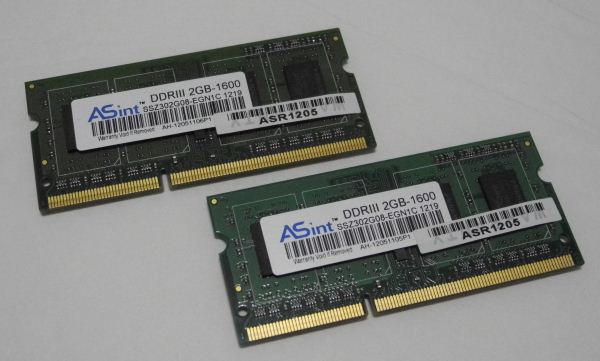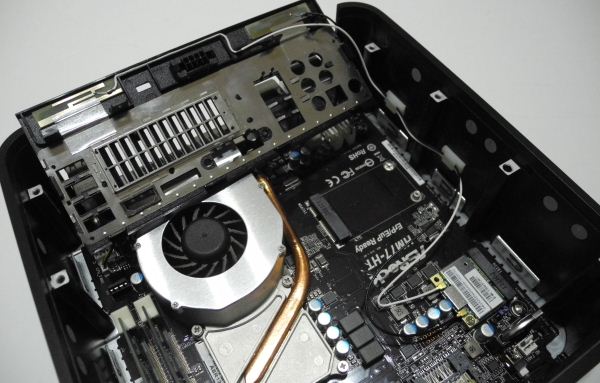ASRock Vision HT: Ivy Bridge Carries the SFF HTPC Forward
by Ganesh T S on November 12, 2012 3:30 PM EST- Posted in
- Home Theater
- ASRock
- HTPC
- Ivy Bridge
System Teardown and Analysis
The ASRock Vision HT 321B is primarily built out of notebook components, and it is quite difficult for the average enthusiast to build such a system with off-the-shelf components.
Motherboard & Chipset : mini-ITX Intel HM77
The motherboard used in the CoreHT series is based on the Panther Point Intel HM77 chipset. There are three SATA headers on the motherboard, with one connected to the hard drive, one to the optical drive and another left unconnected for a second 2.5” drive. The unit also has a mSATA slot. In addition, we also have an eSATA2 port on the rear side of the chassis.
The motherboard exposes four PCIe 2.0 x1 lanes, of which one is connected to the Atheros 9462 WLAN / Bluetooth solution, and the other is connected to the Realtek 8168 GbE controller. As seen in previous ASRock HTPCs, the two sides of the chassis are used as antennae. The two DIMM slots are on the right side of the board, next to the CPU.
CPU : Intel Core i5-3210M
The Core i5-3210M is a 35W TDP processor belonging to the 22nm Intel Ivy Bridge family. Clocking in at 2.50 GHz, it is capable of going up to 3.1 GHz in Turbo mode. The instruction and data caches are 32K each, with a 256 KB common L2 cache. For L3, we have 3MB of Intel Smart Cache shared between the two cores and the integrated GPU.
GPU : Intel HD Graphics 4000
The integrated GPU in the Ivy Bridge processors come in two varieties, namely, HD Graphics 2500 and HD Graphics 4000. The Core i5-3210M uses the latter. It has a base frequency of 650 MHz, and is capable of going up to 1.1 GHz in stressful conditions. It supports full 3D video capabilities, QuickSync v2.0 and WiDi. However, WiDi is not supported by the Vision HT 321B. WiDi makes sense for laptops, but not much for SFF HTPCs. So, we don't fault ASRock for avoiding this feature.
DRAM : ASInt 2 x 2GB DDR3-1600
Compared to the 2x2GB ASInt DDR3-1333 DIMMs used in the CoreHT 252B, ASRock has gone in for an upgrade with a 2x2GB ASInt DDR3-1600 kit for the Vision HT. The memory modules operate at 1.5V with a CAS latency of 11-11-11-28.
Hard Disk : Seagate Momentus Spinpoint 750GB 5400 rpm 2.5"
While the CoreHT 252B used a 7200rpm 500 GB drive, ASRock has opted to increase the storage capacity while bringing down the rotational speed for the Vision HT 321B. The hard drive in the unit is the Seagate Momentus ST750LM022. This drive actually belongs to the Samsung Spinpoint lineup, but Samsung’s hard disk business unit was acquired by Seagate in 2011.
The ST750LM022 isn’t going to win any hard drive benchmarks, but that is acceptable for most HTPC scenarios. Users can always install an additional SSD or mSATA drive as a primary drive for speedy storage.
Optical Disk Drive : Philips Lite-on Blu-ray / DVD RW Slot Loading Drive
The ASRock Vision HT 321B ships with the Philips Lite-on DS-4E1S BD Combo Drive. Unlike last year’s mid-range model, this one sports a slot-loading drive similar to the Vision 3D series. In fact, the drive model is the same as the one shipped with the Vision 3D 137B.
WLAN : Qualcomm Atheros AR5BWB222
ASRock has gone in for a 2T2R dual-band Wi-Fi solution with an integrated Bluetooth 4.0 radio for the Vision HT 321B. In the previous Core series solutions, the sides of the chassis were used as the antennae, but, for the Vision HT 321B, we see that the leads are soldered to the rear end.
As we will see further down in the review, users are in for a much improved wireless performance when the system is used with a capable router.
MCE Remote
ASRock doesn’t include a wireless keyboard / mouse combo with the system. However, we do have an IR receiver in the system, which is taken advantage of by the bundled MCE remote. Unfortunately, the quality of the MCE remote is a big letdown. The keys are quite small and the unit feels cheap in the hand despite being pretty decent in appearance. ASRock has been hesitant to include a better remote despite our repeated requests. Given that the Vision HT series is Bluetooth-enabled, this would have been ideal for ASRock to experiment with a new type of remote.
In the next few sections, we will take a look at the performance of the ASRock Vision HT 321B.














40 Comments
View All Comments
Death666Angel - Tuesday, November 13, 2012 - link
I had a WD TV (the first one I think) and it always annoyed me that it could not decode DTS, which meant that I did not have dual audio for most of my library. It also lacked menu support and Blu Ray support. The menu was terribly slow and browsing a somewhat larger HDD was just awful.I'm sure those boxes have come a long way, but that was the point where I decided I would much rather go all in and have something that I know handles everything I throw at it in one way or another, than to have something that is cheaper and smaller, but worry about whether or not it will play everything I have the way I want it and be burdened by somewhat lacking software/firmware support.
Easy browsing of the web and games are the added bonus and I always have a good back up PC in case one of them breaks and someone needs a quick replacement.
If your set up has never failed you with a film you had, awesome. I have been disappointed by it too much to go back. :)
Jaybus - Tuesday, November 13, 2012 - link
I have two WD-Live boxes and they do have their use. A PC brings several things to the table.To begin with, it brings adaptability. My biggest complaint with set top boxes in general is that it puts you at the mercy of the manufacturer for software fixes / features. When any of the online services change something, it may be months before an update is available. A HTPC is far more adaptable in terms of software.
Another area is remotes. The WD remote is sluggish and is an oddball format that hardly any third party remotes can emulate.
I can see why someone wouldn't care if they don't wish to play games. But it is damn handy to have real surfing capability along with a keyboard and mouse. Is there anything else it beats the set top box in besides surfing and games? Of course! It can do almost anything that a laptop can do! It essentially is a laptop.
prdola0 - Tuesday, November 13, 2012 - link
Atom+ION might be quite slow, but for SFF HTPC usage, it served me quite well. I've been using it for the past two years and it still does the job. Of course it's not a gaming machine - it can't handle anything more demanding than TESIV: Oblivion with low details, but for casual Steam games like Machinarium, Worms Reloaded etc. it's completely sufficient. You shouldn't bash the Atom+ION combo so much. After all, it was the one thing that made this from factor popular, in my opinion.Death666Angel - Tuesday, November 13, 2012 - link
Kinda sad that AsRock does not provide a unit that has an AMD APU inside it. I don't think many HTPC uses are limited by single threaded performance and the better iGPU can make a difference when playing games on the big TV (I use my A6 Llano HTPC as a console sometimes). The only thing I could think of to stop the use of an AMD APU is power consumtion. Pity AMD chooses way too high voltages (I dropped mine from 1.4xxV to 1.15V at max turbo).ericore - Tuesday, November 13, 2012 - link
If you do the math, it costs them about 450$-475$ to build, but you only get a dual core CPU (TRAY: $225.00). Since Intel is charging so much for a mobile dual core, you might as well get the quad core for just under 300$. The whole system retails for 700$. Even at 600$, it would still be a crappy deal. A good deal would include 8 GB of RAM, and quad core CPU for 670$. To top off this shitty deal of theirs, they give you a piece of crap power supply adapter, and cheap plastic enclosure. Apple gives you a solid enclosure and a solid adapter, and ships with the same stuff for 599$.ericore - Tuesday, November 13, 2012 - link
This AMD system is much better value; complete build 250$. I would just wait for Jaguar since current E-350 isn't quite HTPC prime yet.joetekubi - Tuesday, November 13, 2012 - link
Form factor is great, performance would fit my needs, but just a little too procey.I may go for this 6-8 months from now when they version the platform and the old ones
are available for (much) less.
valnar - Wednesday, November 14, 2012 - link
How quiet is it? Does the fan speed up on load? Turn off on idle? What?johnny_boy - Sunday, November 18, 2012 - link
The product isn't bad but compared to a premium machine like a mac mini, the price of the ASRock makes no sense.jeffkibuule - Thursday, November 22, 2012 - link
Mac Mini only has integrated graphics. This system does not.